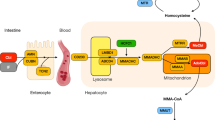Abstract
Background
Methylmalonic aciduria with homocystinuria, cblC defect, is the most frequent disorder of vitamin B12 metabolism. CblC patients are commonly treated with a multidrug therapy to reduce metabolite accumulation and to increase deficient substrates. However the long-term outcome is often unsatisfactory especially in patients with early onset, with frequent progression of neurological and ocular impairment. Recent studies, have shown perturbation of cellular redox status in cblC. To evaluate the potential contribution of oxidative stress into the patophysiology of cblC defect, we have analyzed the in vivo glutathione metabolism in a large series of cblC deficient individuals.
Methods
Levels of different forms of glutathione were measured in lymphocytes obtained from 18 cblC patients and compared with age-matched controls. Furthermore, we also analyzed plasma cysteine and total homocysteine.
Results
We found an imbalance of glutathione metabolism in cblC patients with a significant decrease of total and reduced glutathione, along with a significant increase of different oxidized glutathione forms.
Conclusions
These findings show a relevant in vivo disturbance of glutathione metabolism underlining the contribution of glutathione pool depletion to the redox imbalance in treated cblC patients. Our study may be helpful in addressing future research to better understanding the pathogenetic mechanism of the disease and in developing new therapeutic approaches, including the use of novel vitamin B12 derivatives.


Similar content being viewed by others
References
Atkuri KR, Cowan TM, Kwan T et al (2009) Inherited disorders affecting mitochondrial function are associated with glutathione deficiency and hypocitrullinemia. Proc Natl Acad Sci USA 106:3941–3945
Ballatori N, Krance SM, Notenboom S et al (2009) Glutathione disregulation and the etiology and progression of human disease. Biol Chem 390:191–214
Birch CS, Brasch NE, McCaddon A et al (2009) A novel role for vitamin B12: cobalamis are intracellular antioxidants in vitro. Free Radic Biol Med 47:184–188
Chandler RJ, Zerfas PM, Shanske S et al (2009) Mitochondrial dysfunction in mut methylmalonic acidemia. FASEB J 23:1252–1261
Giustarini D, Rossi R, Milzani A et al (2004) S-glutathionylation: from redox regulation of protein functions to human diseases. J Cell Mol Med 8:201–212
Hannibal L, Kim J, Brasch NE et al (2009) Processing of alkylcobalamins in mammalian cells: a role for the MMACHC (cblC) gene product. Mol Genet Metab 97:260–266
Hannibal L, Smith CA, Jacobsen D (2010) The X-ray crystal structure of glutathionylcobalamin revealed. Inorg Chem 49:9921–9927
Hannibal L, DiBello P, Yu M et al (2011) The MMACHC proteome: hallmarks of functional cobalamin deficiency in humans. Mol Genet Metab 103:226–239
Jacobsen D, Troxell LS, Brown KL (1984) Catalysis of thiol oxidation by cobalamins and cobinamides: reaction products and kinetics. Biochemistry 23:2017–2025
Jeong J, Ha TS, Kim J (2011) Protection of aquo/hydroxocobalamin from reduced glutathione by a B12 trafficking chaperone. BMB Rep 44:170–175
Jouvet P, Rustin P, Taylor DL et al (2000) Branched chain amino acids induce apoptosis in neural cells without mitochondrial membrane depolarization or cytochrome c release: implications for neurological impairment associated with maple syrup urine disease. Mol Biol Cell 11:1919–1932
Kim J, Gherasim C, Banerje R (2008) Decyanation of vitamin B12 by a trafficking chaperone. Proc Natl Acad Sci USA 105:14551–14554
Lerner-Ellis JP, Tirone JC, Pawelek PD et al (2006) Identification of the gene responsible for methylmalonic aciduria and homocystinuria, CblC type. Nat Genet 38:93–100
Lu SC (2009) Regulation of glutathione synthesis. Mol Aspect Med 30:42–59
Martinelli G, Deodato F, Dionisi-Vici C (2011) Cobalamin C defect: natural history, pathophysiology, and treatment. J Inherit Metab Dis 34:127–135
Mc Guire PJ, Parikh A, Diaz GA (2009) Profiling of oxidative stress in patients with inborn errors of metabolism. Mol Genet Metab 98:173–180
Mosharov E, Cranford MR, Baneriee R (2000) The quantitatively important relationship between homocysteine metabolism and glutathione synthesis by the transsulfuration pathway and its regulation by redox changes. Biochemistry 39:13005–13011
Nome F, Fendler JH (1976) Interaction of cysteine with vitamin B12a: kinetic and thermodynamic investigations. J Chem Soc Dalton Trans 13:1212–1219
Pastore A, Piemonte F (2012) S-glutathionylation signaling in cell biology: progress and prospects. Eur J Pharm Sci 46:279–292
Pastore A, Massoud R, Motti C (1998) Fully automated assay for total homocysteine, cysteine, cysteinylglycine, glutathione, cysteamine, and 2-mercaptopropionylglycine in plasma and urine. Clin Chem 44:825–832
Pastore A, Federici G, Bertini E, Piemonte F (2003) Analysis of glutathione: implication in redox and detoxification. Clin Chim Acta 333:19–39
Richard E, Jorge-Finnigan A, Garcia-Villoria J (2009) Genetic and cellular studies of oxidative stress in Methylmalonic Aciduria (MMA) Cobalamin Deficiency Type C (cblC) with Homocystinuria (MMACHC). Hum Mutat 30:1558–1566
Richard E, Desviat LR, Ugarte M, Perez B (2013) Oxidative stress and apoptosis in homocystinuria patients with genetic remetilation defects. J Cell Biochem 114:183–191
Sirtori LR, Dutra-Filho CS, Fitarelli D (2005) Oxidative stress in patients with phenylketonuria. Biochim Biophys Acta 1740:68–73
Xia L, Cregan AG, Berben LA, Brasch NE (2004) Studies on the formation of glutathionylcobalamin: any free intracellular aquacobalamin is likely to be rapidly and irreversibly converted to glutathionylcobalamin. Inorg Chem 43:6848–6857
Acknowledgment
The financial support of Mariani Foundation of Milan (Grant n. R-12-92) is gratefully acknowledged.
Details of funding
The study was financed by Mariani Foundation of Milan (Grant n. R-12-92). The authors confirm independence from the sponsors; the content of the article has not been influenced by sponsors.
Conflict of interest
None.
Author information
Authors and Affiliations
Corresponding author
Additional information
Communicated by: Brian Fowler
Anna Pastore and Diego Martinelli these authors contributed equally to this work.
Rights and permissions
About this article
Cite this article
Pastore, A., Martinelli, D., Piemonte, F. et al. Glutathione metabolism in cobalamin deficiency type C (cblC). J Inherit Metab Dis 37, 125–129 (2014). https://doi.org/10.1007/s10545-013-9605-3
Received:
Revised:
Accepted:
Published:
Issue Date:
DOI: https://doi.org/10.1007/s10545-013-9605-3




